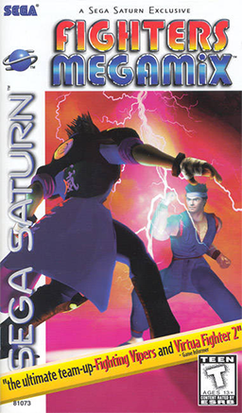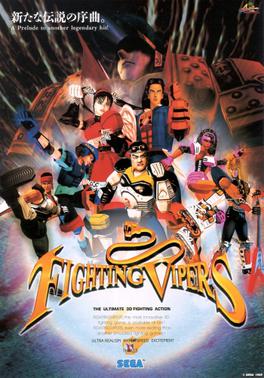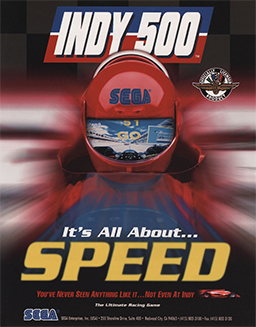
The Sega Saturn is a home video game console developed by Sega and released on November 22, 1994, in Japan, May 11, 1995, in North America, and July 8, 1995, in Europe. Part of the fifth generation of video game consoles, it is the successor to the successful Genesis. The Saturn has a dual-CPU architecture and eight processors. Its games are in CD-ROM format, including several ports of arcade games and original games.

Virtua Fighter is a fighting game created for the Sega Model 1 arcade platform by AM2, a development group within Sega, headed by Yu Suzuki. An early prototype version was location tested in Japan by August 1993, before the complete game was released worldwide in December 1993. It is the first game in the Virtua Fighter series, and the first arcade fighting game to feature fully 3D polygon graphics. The game has been ported to several platforms including the Sega Saturn, Sega 32X, and Microsoft Windows.

Virtua Cop is a 1994 light gun shooter game developed by Sega AM2 and designed by Yu Suzuki. It was originally an arcade game on the Sega Model 2 system, and was ported to the Sega Saturn in 1995 and Windows in 1996. The Saturn version included support for both the Virtua Gun and Saturn mouse, as well as a new "Training Mode" which consists of a randomly generated shooting gallery.

Yu Suzuki is a Japanese game designer, producer, programmer, and engineer, who headed Sega's AM2 team for 18 years. Considered one of the first auteurs of video games, he has been responsible for a number of Sega's arcade hits, including three-dimensional sprite-scaling games that used "taikan" motion simulator arcade cabinets, such as Hang-On, Space Harrier, Out Run and After Burner, and pioneering polygonal 3D games such as Virtua Racing and Virtua Fighter, which are some of the games besides others from rival companies during that era credited with popularizing 3D graphics in video games; as well as the critically acclaimed Shenmue series. As a hardware engineer, he led the development of various arcade system boards, including the Sega Space Harrier, Model 1, Model 2 and Model 3, and was involved in the technical development of the Dreamcast console and its corresponding NAOMI arcade hardware.

Sega Rally Championship is a 1994 racing game developed by Sega AM3 and published by Sega. Originally released for arcades using the Sega Model 2 board, ports were published for the Sega Saturn in 1995 and Microsoft Windows in 1997. Sega Rally Championship simulates driving on different surfaces, with different friction properties, with the car's handling changing accordingly. As the first racing game to incorporate this feature, Sega Rally Championship is considered to be one of the milestones in the evolution of the racing game genre. It was also an early rally racing game and featured cooperative gameplay alongside the usual competitive multiplayer.

Virtua Racing or V.R. for short, is a Formula One racing video game developed by Sega AM2 and released for arcades in 1992. Virtua Racing was initially a proof-of-concept application for exercising a new 3D graphics platform under development, the "Model 1". The results were so encouraging that Virtua Racing was fully developed into a standalone arcade title.

Sega AM Research & Development No. 2, previously known as SEGA-AM2 Co., Ltd., is a video game development team within the Japanese multinational video game developer Sega. Yu Suzuki, who had previously developed arcade games for Sega including Hang-On and Out Run, was the first manager of the department.

Virtua Cop 2 is a light gun shooter arcade game, released in 1995 and developed internally at Sega by their AM2 studio. It was ported to the Sega Saturn in 1996, PC in 1997, and Sega Dreamcast in 2000. It was bundled with Virtua Cop in Virtua Cop: Elite Edition for PlayStation 2 in 2002.

Fighters Megamix is a 1996 fighting game developed by Sega AM2 for the Sega Saturn. It is a crossover between Sega's 3D arcade fighting games Virtua Fighter 2 and Fighting Vipers, with unlockable characters from several other AM2 games such as Virtua Cop 2 and Daytona USA. It allows gamers to play as the bosses of both Virtua Fighter 2 and Fighting Vipers without codes.

Virtua Striker is a series of association football sports video games released by Sega for arcades. Originally developed by Sega AM2 from 1994 to 1999, the series moved to Amusement Vision with Virtua Striker 3, but it later moved to Sega Sports Design R&D Dept. with Virtua Striker 4.

Virtua Fighter 2 is a 1994 fighting video game developed by Sega. It is the sequel to Virtua Fighter (1993), and the second game in the Virtua Fighter series. It was created by Sega's Yu Suzuki-headed AM2 and was released for arcades in 1994. Ports were released for the Sega Saturn in 1995 and Microsoft Windows in 1997.

Fighting Vipers is a 3D fighting video game developed by Sega AM2. It uses the same game engine as AM2's Virtua Fighter 2 but features enclosed arenas and an armor mechanic, and was targeted more towards Western audiences, using a U.S. setting and more freeform styles of martial arts. The game was released in the arcade in 1995 using the Sega Model 2 hardware. The game was ported to the Sega Saturn, and to PlayStation Network and Xbox Live Arcade in 2012. Though Fighting Vipers was not very popular in North American arcades, the Saturn version was one of the most high-profile games in the system's 1996 holiday lineup, and was met with positive reviews.

F1 Challenge is an officially licensed Formula One game developed by Bell Corporation and produced by Sega for the Sega Saturn. The game contains only three of the many Formula One circuits – Hockenheim, Monte Carlo, and Suzuka – while having another three based on the fictional Neo City, containing three different configurations.

Virtua Fighter 3 is the sequel to 1994's Virtua Fighter 2 and the third fighting game in the Virtua Fighter series, developed by Sega AM2 and published by Sega in 1996. It was the first arcade game to run on the Sega Model 3 system board.
Virtua Fighter is a series of fighting games created by Sega AM2 and designer Yu Suzuki. The original Virtua Fighter was released in December 1993 and has received four main sequels and several spin-offs. The highly influential first Virtua Fighter game is widely recognized as the first 3D fighting game released.

Scud Race is an arcade racing video game released by Sega in 1996. It is the first racing game to use the Sega Model 3 hardware. Despite being released well within the lifetime of the Sega Saturn, no Saturn port was ever released. A Dreamcast port was announced for the system's 1998 launch lineup and was shown as a tech-demo in the Dreamcast Presentation in 1998, but was cancelled.

Ridge Racer is a 1993 racing video game developed and published by Namco. It was released initially on the Namco System 22 arcade system board and ported to the PlayStation console in 1994. It is the first title in the Ridge Racer series released for arcades and home consoles.

Ace Driver is a 1994 racing arcade game developed and published by Namco. The player controls a Formula One racer, with the objective being to complete three laps of a race course and to avoid a collision with opponents and other obstacles. Three difficulty levels are available, as is a mode to enable a gear shift. Similar to Namco's own Final Lap series, the arcade cabinet can be linked together with another unit to enable eight-person multiplayer. It ran on the Namco System 22 arcade hardware.

Daytona USA: Championship Circuit Edition, or Daytona USA: Circuit Edition in Japan, is a racing game by Sega, specifically designed for the Sega Saturn. Released in 1996, it is a reworked and extended version of the original Daytona USA, and was developed by Sega AM3, the same team that oversaw the Saturn port of Sega Rally Championship, by using a modified version of the Sega Saturn engine of Sega Rally Championship.

Indy 500 is a 1995 arcade racing game developed by Sega AM1. Based on the IndyCar Series, the game possesses a license from the Indianapolis Motor Speedway, home of the Indianapolis 500, and includes the speedway as one of its courses. Indy 500 was AM1's second game developed using 3D computer graphics and their first to utilize color textures. While planned as a Model 3 arcade system board release, delays in the hardware's completion led to use of the Model 2 instead. A Sega Saturn port was planned, but later canceled. Reception to Indy 500 was mixed, with some critical comparison to other games such as Sega AM2's Daytona USA and Namco's Ace Driver and Rave Racer.






















